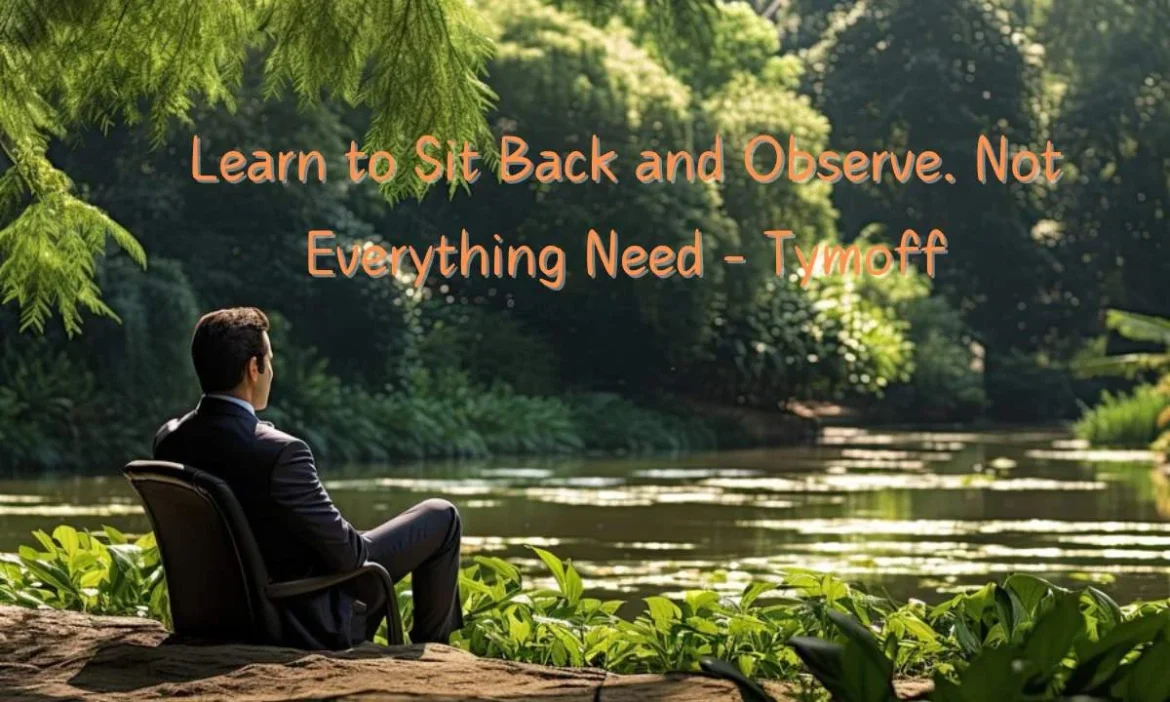
Discover why it’s important to learn to sit back and observe. Not everything need your immediate reaction. Tymoff’s principles can help you develop patience, mindfulness, and clarity in decision-making.
Introduction
In today’s fast-paced world, people often feel compelled to react instantly to every situation. Whether it’s responding to a message, reacting to a heated argument, or making a quick decision, the pressure to act immediately can sometimes lead to negative consequences. However, there’s a growing realization that learning to sit back and observe—rather than immediately reacting—is a powerful tool for personal growth and mental well-being.
The phrase “learn to sit back and observe. Not everything need” reflects the wisdom of mindfulness, patience, and self-control. This approach encourages you to step back, take a breath, and assess situations before responding. Inspired by Tymoff’s philosophy, this article will dive deep into why it’s essential to develop the habit of observing first, the benefits it brings to your life, and how you can apply this principle in everyday situations.
What Does It Mean to “Sit Back and Observe”?
At its core, the idea to “sit back and observe” revolves around the concept of mindfulness and emotional intelligence. It means taking a pause before jumping to conclusions or decisions. By doing this, you allow yourself to assess situations more objectively, understand your emotions, and react in a way that benefits both you and those around you.
Many people often mistake observation for inaction or passivity, but this isn’t the case. When you take the time to observe, you gather information, gain clarity, and cultivate insight, which leads to more thoughtful and effective actions.
Learn to Sit Back and Observe. Not Everything Need Immediate Reaction – Tymoff’s Approach
Tymoff’s philosophy emphasizes the power of patience and restraint in a world that constantly demands instant responses. By sitting back and observing, you give yourself the opportunity to make better decisions, improve your relationships, and enhance your overall well-being. Here’s how you can integrate this approach into your daily life.

1. Mindfulness and Awareness
Learning to observe without judgment is a core aspect of mindfulness. By being present in the moment, you can see situations clearly without allowing your emotions or biases to cloud your perception. The act of simply observing helps you stay grounded and can prevent emotional outbursts or hasty decisions that you may regret later.
To practice mindfulness, you can start by:
- Taking a few deep breaths when you feel overwhelmed.
- Focusing on the sensations around you—what you see, hear, and feel.
- Observing your emotions as they arise without reacting immediately.
2. Patience and Self-Control
Patience is a virtue, and learning to sit back and observe cultivates this quality. In many situations, reacting immediately can lead to unnecessary conflict or stress. By waiting, you allow yourself to fully understand the situation, which often leads to more thoughtful responses.
For example:
- During arguments, instead of immediately defending yourself, take a moment to listen to the other person’s point of view.
- In decision-making, give yourself time to weigh the pros and cons before jumping to conclusions.
3. Clarity in Decision-Making
When you give yourself time to observe and reflect, you develop clarity. Whether you’re dealing with a personal issue or a professional dilemma, the ability to sit back and analyze the situation helps you make well-informed decisions.
By practicing the principle of “learn to sit back and observe, not everything need” immediate action, you:
- Avoid rash decisions driven by stress or fear.
- Gain a broader perspective on the problem at hand.
- Make decisions that align with your long-term goals.
4. Improved Relationships
In relationships, whether personal or professional, communication plays a crucial role. Often, we feel the need to react quickly during disagreements or conflicts, but taking a moment to observe and process the situation can lead to more productive conversations.
For instance:
- If your partner says something that upsets you, instead of reacting angrily, sit back, take a deep breath, and consider their perspective before responding.
- In a work environment, rather than immediately responding to feedback or criticism, take time to reflect on it, which allows for more constructive discussions.
Benefits of Learning to Sit Back and Observe
When you consistently apply the “learn to sit back and observe” mindset, you’ll begin to see significant improvements in many areas of your life. Here are the key benefits of adopting this approach:
1. Reduced Stress and Anxiety
By giving yourself permission to pause and observe, you reduce the constant pressure to act immediately. This leads to less stress and anxiety, as you no longer feel overwhelmed by the need to constantly “do” something.
2. Better Decision-Making
Observing situations before reacting helps you make better decisions. Whether in your personal life or career, you can weigh your options carefully and choose the most beneficial path forward.
3. Enhanced Emotional Intelligence
Taking time to observe your emotions and those of others improves emotional intelligence. You become more aware of how you’re feeling, why you’re feeling it, and how your actions might affect others.
4. Improved Relationships
When you learn to observe rather than react impulsively, you strengthen your relationships. You become a better listener and communicator, which leads to deeper connections with others.
5. Personal Growth
Learning to sit back and observe fosters personal growth. It allows you to reflect on your behaviors, habits, and reactions, helping you to become more self-aware and aligned with your values.
How to Practice Sitting Back and Observing in Everyday Life
Incorporating this principle into your daily life doesn’t happen overnight, but with practice, it can become a natural habit. Here are some practical ways to implement the “sit back and observe” mindset:
1. Start Your Day with Mindfulness
Before diving into your daily tasks, take a few minutes to sit quietly, breathe deeply, and focus on the present moment. This simple practice helps set the tone for a more mindful day.
2. Pause Before Responding
Whenever you feel the urge to react quickly, pause for a few moments. This pause allows you to gather your thoughts, assess the situation, and respond more effectively.
3. Observe Without Judging
When observing others or your own thoughts, try to do so without immediately labeling or judging them. Simply watch what’s happening, and allow yourself to process before forming an opinion.
4. Journal Your Observations
At the end of the day, take a few minutes to reflect on situations where you practiced sitting back and observing. Writing down your thoughts can help reinforce this habit and provide insights for improvement.
FAQs on Learning to Sit Back and Observe
Q1: How long does it take to develop the habit of sitting back and observing?
- Developing this habit can vary from person to person. With consistent practice, you may start to see positive changes within a few weeks. The key is to remain patient with yourself and keep practicing.
Q2: Is sitting back and observing the same as avoiding conflict?
- No, sitting back and observing is not about avoiding conflict but about managing it better. By observing first, you handle conflict with greater clarity and emotional intelligence.
Q3: Can sitting back and observing help in decision-making?
- Yes, observing before reacting helps you gather more information and see things from different perspectives, leading to more thoughtful decisions.
Q4: Does sitting back and observing mean I should never act?
- Not at all. It’s about timing your actions wisely. Sitting back and observing gives you the information you need to act more effectively when the time is right.
Q5: How can I stay calm while sitting back and observing during stressful situations?
- Deep breathing exercises, mindfulness techniques, and focusing on the present moment can help you stay calm and composed, even in stressful situations.
Conclusion
Learning to sit back and observe. Not everything need your immediate attention, and understanding this can bring a sense of peace and clarity to your life. By applying Tymoff’s philosophy, you can improve your decision-making, enhance your relationships, and cultivate greater emotional intelligence.
Remember, it’s not about inaction but about mindful observation that leads to purposeful action. By practicing this habit regularly, you’ll experience personal growth, reduced stress, and a more balanced approach to life.



